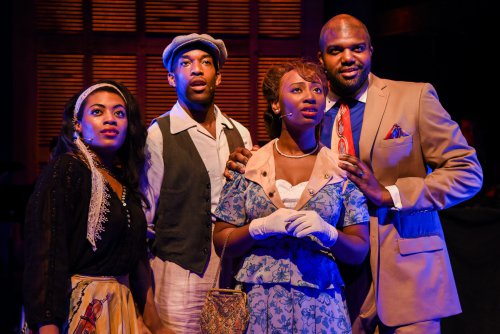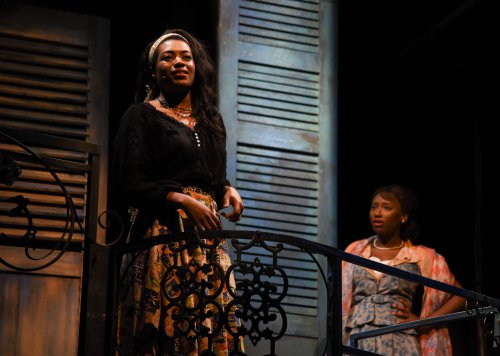For the Last Time
Wonderful jazz score and magnificent musical performances elevate this thin dramatization of Hawthorne’s 1860 “The Marble Faun,” moved from Rome to New Orleans 1950.

Brittany Campbell, Britton Smith, Anita Welch and Carl Clemons-Hopkins in a scene from “For the Last Time” (Photo credit: Russ Rowland)
[avatar user=”Victor Gluck” size=”96″ align=”left” ] Victor Gluck, Editor-in-Chief[/avatar] As a follow-up to their musical based on Fitzgerald’s This Side of Paradise, lyricist/composer Nancy Harrow and writer/director Will Pomerantz have turned their sights on Nathaniel Hawthorne’s 1860 novel, The Marble Faun. Renamed For the Last Time, this new jazz musical has changed the setting from Rome in 1860 to New Orleans, circa 1950, and uses an all-Black cast to tell the original story. The show’s glory is its magnificent score, a combination of jazz and blues ballads, wonderfully sung by its cast of seven. The problem is that the show started as a concept album and to some extent hasn’t progressed very far from there: the book by Pomerantz and Harrow remains too thin to deal with the plot’s very deep themes.
Hawthorne’s 19th century novel tells a story of three artists living in Rome who befriend an Italian count who lives for sensuous pleasure. In the first chapter, when they see the famous statue of the Marble Faun by Praxiteles in the sculpture gallery of the Capitol, they notice that Count Donatello resembles the statue almost exactly. From then on Miriam, a painter of mysterious origins, and the American artists Kenyon and Hilda refer to Donatello as this supernatural being and notice that his personality is half human/half faun-like.
When a terrible act of violence occurs, Donatello’s nature changes and he is transformed into a penitent, conscience-stricken human for the first time, losing his sunny carefree nature. Dealing with metaphysics, religion and aesthetics throughout, the novel’s second half concerns the working out of the guilt of all four characters. The book ends with the Roman Carnival while the musical uses New Orleans’ Mardi Gras as the first act finale. The novel’s original title as published in Britain was called Transformation, a Romance which emphasizes its key theme. While not much read today, The Marble Faun was extremely influential in its own time and credited with inventing the International Theme of Americans in Europe which Henry James was later to make his life work.
While the musical includes the scene in the museum reset to New Orleans, it drops the metaphysical, religious and aesthetic themes of the novel. And although the musical’s Donatello is said to resemble the statue, this fact is never used as a metaphor or a plot device. Consequently, both the characters and book appear very thin. Although John McDermott’s two-level set with its lace balconies goes a long way to creating atmosphere, other than changing Carnival to Mardi Gras, the New Orleans setting is hardly used. One markedly significant change from the novel is that although Miriam’s deep dark secret is never revealed by Hawthorne, even in the afterword he wrote for the second edition, Pomerantz and Harrow have come up with a secret shocking enough to fill the bill.
This thinness of plot is not true of Harrow’s rich and varied score, brilliantly arranged and orchestrated by Dennis Mackrel, as well as expertly conducted by Cody Owen Stine who leads the eight person jazz band with himself on piano. While the performers are perfectly fine in their duets and quartets, it is not until their solos that they are allowed to let loose and demonstrate the full dimension of their musical talents. Harrow’s lyrics are deceptively simple giving the musical the sense of a story from the past and characters not adept in revealing their feelings.
While the actors are obviously expert performers, here they are only as successful as the dramatic opportunities they have been given. In the three-dimensional role of the troubled Miriam, Brittany Campbell, dressed in Whitney Locher’s flattering bohemian outfits, is the most real character in the story. As her friend and fellow New Orleans denizen Kenyon, in the musical a band conductor and club owner, Carl Clemons-Hopkins makes a strong impression, as an authority figure.
Hilda, here Miriam’s artist cousin from back home come for a permanent stay, Anita Welch is somewhat hampered by the fact that the musical doesn’t make her religious beliefs and near conversion to Catholicism real. Given the most difficult role (how does one portray a human faun?), Britton Smith has chosen to play Donatello, here a trumpet player from the bayou country, as a naïve, inexperienced young man unaware of the ways of the city. Inevitably he is the least convincing character though he displays a great deal of passion. Reggie D. White as both the narrator and as Miriam’s art teacher who has followed her from Chicago does less well in an underwritten role, used mainly as a dramatic device.
For the Last Time, whose title comes from the final song of the evening but says little about the preceding show, works best as a staged concert. Its performers, both singers and musicians, give a magnificent reading of Nancy Harrow’s lush and vibrant score. As a New Orleans version of Nathaniel Hawthorne’s influential but not much read novel The Marble Faun, the musical works less well.
For the Last Time (through June 20, 2015)
The Clurman Theatre at Theatre Row, 410 W. 42nd Street, in Manhattan
For tickets, call 212-239-6200 or visit http://www.forthelasttimemusical.com
Running time: two hours with one intermission







Leave a comment